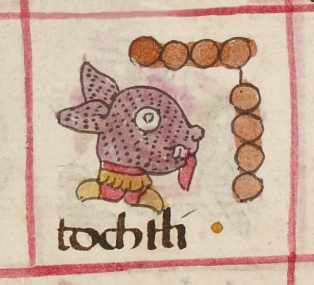tochtli (TR8r)
This colorful simplex glyph from the Codex Telleriano-Remensis shows a rabbit (tochtli). It has been taken from a date. The rabbit was both a day sign and a year sign in the calendar. Here, it is shown in profile, looking toward the viewer's right. Its coat is dotted and painted a purplish color. Its visible eye, which has been left white, is wide open. Its protruding teeth are also white, and its long, protruding tongue is red. Its neck has the look of having been severed, with a red ring at the throat and, below that, a yellow scalloped or jagged edge. Below that are what appear to be internal organs, red and yellow.
Stephanie Wood
Organs, as shown below, typically come in red and yellow. Scalloped yellow edges can suggest a severing, such as can be seen in the severed part of the tree of Tamoanchan (also below). The autonomous-era sculpture of the divine force of Coyolxauhqui, who was cut into many pieces, has these scalloped edges all over it. For more on red and yellow interiors, see the article on the left navigation bar.
Stephanie Wood
tochtli
Stephanie Wood
ca. 1550–1563
Jeff Haskett-Wood
rabbits, conejos, fechas, dates, calendarios, órganos, organs, lenguas, tongues, xiuhpohualli, año, turquesa, xihuitl

tocht(li), rabbit, a calendrical marker and the shape seen in the moon, https://nahuatl.wired-humanities.org/content/tochtli
Telleriano-Remensis Codex, folio 8 recto, MS Mexicain 385, Gallica digital collection, https://gallica.bnf.fr/ark:/12148/btv1b8458267s/f41.item.zoom
The non-commercial reuse of images from the Bibliothèque nationale de France is free as long as the user is in compliance with the legislation in force and provides the citation: “Source gallica.bnf.fr / Bibliothèque nationale de France” or “Source gallica.bnf.fr / BnF.”







